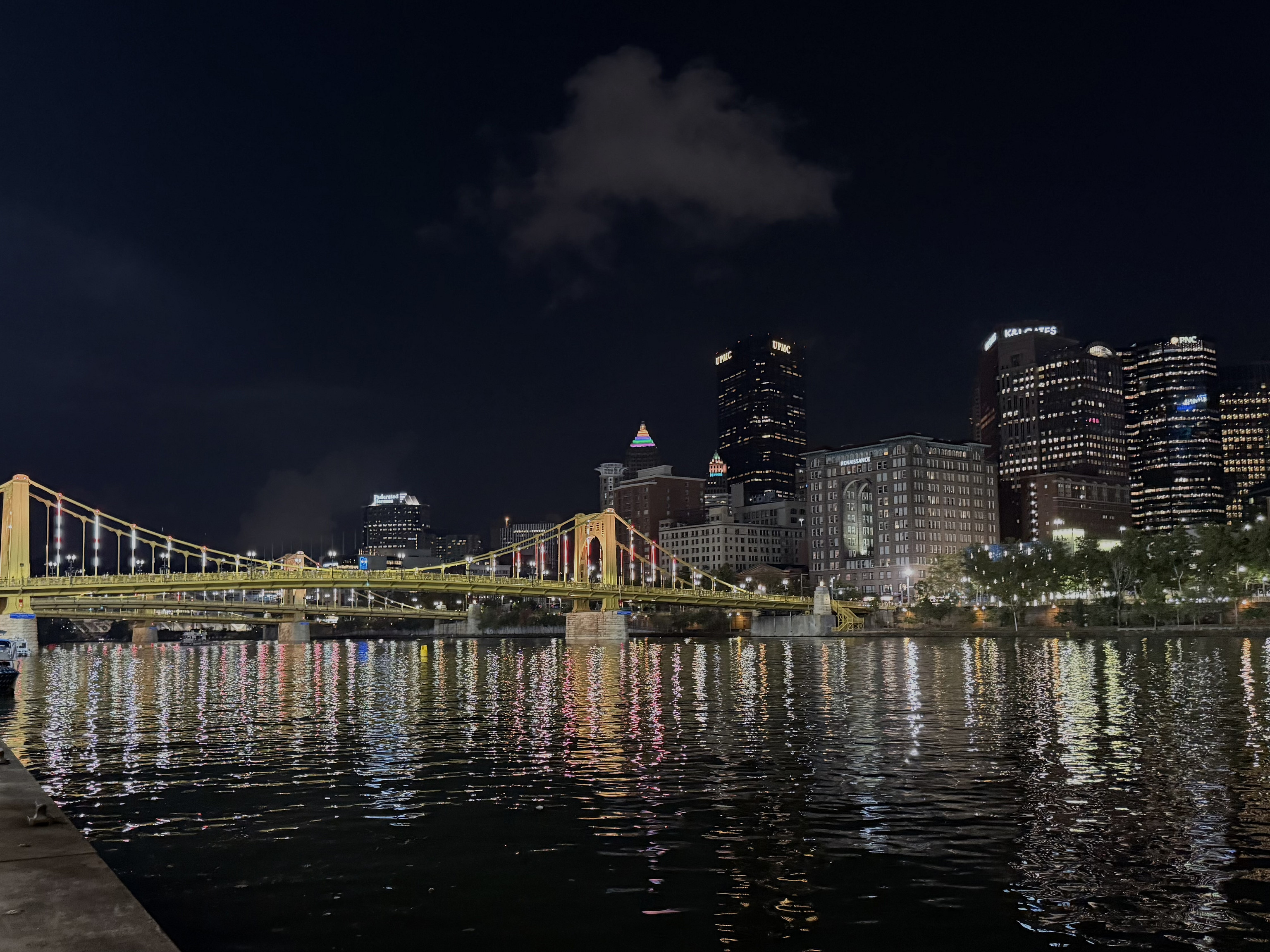
The backyard of my childhood home, Pocatello, Idaho. When I was a kid it was potatoes on the other side of the fence.

The backyard of my childhood home, Pocatello, Idaho. When I was a kid it was potatoes on the other side of the fence.
Proud of my kiddo who raised $200 for the Trevor Project by selling crocheted frogs at a “marketplace” event put on by the high school.
Many years after starting, I finally finished Robert Jordan’s Wheel of Time series. I think I did the whole thing by audiobook, which by my calculations (assuming my typical 1.4x speed) is 321 hours of audio. Great series!
I’m slowly moving to Jujutsu for my version control needs. For years, I’ve been using Mercurial-based interface to Piper at work and Git at home, and switching challenges my muscle memory. Jujutsu provides a common interface that can handle a central repo in either format. I find it easier to work with than Git or Mercurial, but there is a learning curve.

Roberto Clemente Bridge and Downtown Pittsburgh

Mellon Square, Pittsburgh. I love how much seating there is at this park, even if no one was taking advantage.
It is long past time for a screenshot file type. Pixel-based image format with selectable text and clickable links, annotations, and a context link to view the original source.
(Most of this you could do with pdf, but you could also do it more simply. Either way, phones and computers should be able to create them properly from apps and web pages.)
I feel very powerless to stop the intentional harm and destruction caused by Trump and Republicans in power, but I have absolutely no time for anyone or any organization that is happy about the way things are going, who sees Trump as a means to get something they want, or who sees Republicans as the lesser of two evils.
I installed the iPad beta to try the new windowing and I mostly love it. My main complaint is that I sometimes, maybe even always, want a window to go away and come back full screen next time, so much that I find myself maximizing a window before closing it. I would probably be fine if closing a window made it forget its size, and just minimize when you want to preserve the size.
I have two or three web pages that I tend to keep open on my desktop Mac. From time to time I have experimented with turning these into web apps, which makes it possible for me to hide them independently of my other web browser windows, helps them remember the appropriate window size, and helps me to not accidentally change them to a different page.
I was happy to discover that Safari makes it easier than ever to convert a page
into a web app. Just select “Add to Dock” in the File menu (or share sheet). It
puts an icon in the Dock, but you don’t have to leave it there because it also
puts an application in ~/Applications.
But one of my pages is an HTML dashboard that is just a local file on my computer. I originally made it this way because it syncs via iCloud Drive, so that I can also view it on my phone or iPad if necessary. For some reason, you can’t make a web app to view a local file.
The good thing about the Mac is that you can work around almost anything, building exactly what you want out of smaller pieces. And in this case, all you need is a little program that responds to HTTP requests with the content of the file.
There are many ways to accomplish this. I think MacOS still comes with Apache installed by default. It is running on my machine, at least. But I don’t like configuring Apache, so I didn’t use this method.
Python can make an HTTP server easily, just run
python -m http.server -b localhost -d /path/to/directory 8203
The -m flag runs the http.server module as if it were a Python script
(that is, with __name__ == "__main__"). In this case, it starts up a server
with the given options. The -b flag tells it to listen on localhost, so
that other computers on your network can’t access the page. Then you give it a
directory and a port number. After this you can visit
http://localhost:8203/file.html and view the file.
But Python technically serves the entire directory, not just the file. You
could write a custom Python script that imported http.server, and probably
build exactly what you wanted. But when I want a tiny program, I always seem to
gravitate towards Go, even though I tend to hate it for larger programs. I
probably like it because you can compile a binary that has no dependencies,
which reminds me of Turbo Pascal.
Here is a simple Go program that serves a single file at the port, and redirects any other requests to the base URL:
package main
import (
"flag"
"log"
"net/http"
"os"
)
func main() {
bind := flag.String("bind", "127.0.0.1:8011", "The address to listen on.")
filename := flag.String("file", "", "The file to serve")
flag.Parse()
if *filename == "" {
flag.Usage()
os.Exit(1)
}
http.HandleFunc("/", func(w http.ResponseWriter, r *http.Request) {
if r.URL.Path == "/" {
http.ServeFile(w, r, *filename)
} else {
http.Redirect(w, r, "/", http.StatusMovedPermanently)
}
})
log.Printf("Starting server at %s", *bind)
log.Fatal(http.ListenAndServe(*bind, nil))
}
I called it servefile.go, then you just run go build servefile.go and it
creates a binary named servefile.
If you go the Apache route, MacOS will already keep the server alive for you. If you go the Python or Go route, you need to tell the system to always run your server.
The easiest way is to buy LaunchControl and create a new agent to run your command, checking “Run at load” and “Keep alive no matter what.”
For more information, check out this 13-year-old article on scheduling with launchd.
¿Qué dijo una estatua a la otra?
¡No te movái!
In English, “What did one statue say to the other? Don’t move!”
On a kindergarten level, this is already funny, because statues are known for their ability to not move.
But what makes it a pun is that, in a Chilean accent, movái is a homophone of Moai, the well-known Easter Island statues.
In fact, anywhere else in the Spanish-speaking world you would say “No te muevas” (or in Argentina “No te movás”), which would ruin the joke. But in the Chilean voseo form, this becomes “No te movái.” And Chileans, who often drop consonants, especially v’s, and even more so when getting all voseo-folksy, would say “No te moai.”
Idea for an app: You ask questions, it gives you answers. If it is wrong, you get $5. It is allowed to say “I’m not sure, but here is my best guess,” in which case there are no guarantees.
For Independence Day, we had tickets to the Dodgers game, and my daughter was excited about the prospect of a fireworks show. The fireworks were great, although it was a little awkward as tens of thousands of fans had to sit through an 18-1 blowout just to get to the end of game celebration.
The ceremonial first pitch was thrown out by Rick Monday, Dodgers royalty who, as a player, was before my time but who is known more broadly for his work on the radio broadcasts, which I rarely listen to. Not enough to have any personal feelings toward him as a person or personality.
The July 4th tie-in was the time that Monday “heroically” saved an American flag from a center field protest in 1976 at Dodger Stadium.
I grew up in Idaho, in the 90s, as a member of the Boy Scouts, surrounded by Vietnam veterans. So I absorbed a lot of the content-free “disrespecting America should be illegal” discourse that always completely sidestepped the ideologies of the protests and treated the protesters as rabid America haters. But I also heard the personal stories of men who went through hell, telling themselves that their country needed their sacrifice, only to arrive home and find out that the situation was more nuanced than that.
So I was understandably skeptical about the whole rah-rah America attitude, especially while a whole segment of our leaders are intent on destroying our institutions and calling it patriotism, while a large portion of the population is intent on respecting their authority and calling it patriotism. Of course, it didn’t help that Monday paired up with election denier Blake Treinen to throw out the first pitch. And I wasn’t terribly surprised to find out that at one point Monday tried to save the American flag from Colin Kaepernick as well.
Kudos to the Dodgers, however, for picking Lauren Evans to sing the national anthem. In a time when mediocre white men are shameless enough to claim with a straight face that the existence of a minority in power is evidence of anti-White racism, it is good to be reminded that a Black woman can match and beat their “patriotism”.
And while the Dodgers, mercifully, don’t generally follow the “God Bless America” tradition, they made an exception for Independence Day. But once again, they asked Lauren Evans to sing, and it was good to be reminded that this is her land, her home, my land, my home, their land, their home, and not just Trump’s land, however much he wants to claim it for his own.
I like to think someone in the organization planned the whole thing to piss Rick Monday off. They even managed to show him on the video boards, standing as Evans sang for blessings on our mountains and our prairies, looking bored out of his mind.

Shoseien Garden, Kyoto

Kumatakasha, Fushimi Inari Shrine, Kyoto